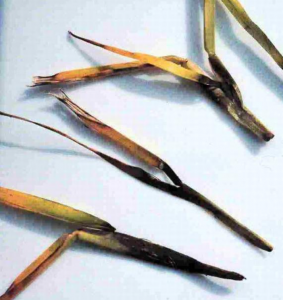Diseases are problematic when all three conditions are satisfied:
- Disease present
- Susceptible plant
- Favorable environment
Large Patch, also known as Brown Patch, is a disease of warm season turfgrasses that rears its ugly head during the most beautiful time of the year, Florida Fall. The cooler conditions below 80 degrees combined with prolonged wetness encourages Large Patch growth in the turf.
Think about things that you can and cannot control. Temperature is managed by nature. Rain, also nature. But irrigation and fertilization, those are things completely within your control and how you manage these things will influence how well you can manage disease. Reduce irrigation as the season slows and the days become shorter and cooler. Stick to balanced fertilizers with a slow-release nitrogen source. Too much nitrogen will focus on pushing new growth resulting in a stressed-out plant less capable of preventing diseases.

Did you have a disease issue last year?
Keep records! The history of a site will help to predict potential problems and develop management strategies such as reducing irrigation. Even the best fungicides have limited ability to cure fungal issues. Fungicides stop the spread of the disease or prevent the disease from spreading. That is why recordkeeping is one of the best ways to know what to expect, how to prevent, and what to prepare if conditions are ripe for disease development.
What does it look and smell like?

Diseases have certain characteristics. Large patch begins with a soft brown rot at the base of the leaf. It has a certain rotted stank to it and will easily pull out of the leaf sheath. Next, the disease will expand to patches yellowish in color and about 1 foot wide. The disease will continue to spread and show more reddish browns in the dying patch of grass, more dead in the outer ring of the patch with some survivors hanging in the center. The roots remain unaffected by the disease.
Your chemical options will differ based on whether you are professionally licensed to apply certain chemicals. Here is a link to more information: https://edis.ifas.ufl.edu/publication/LH044.
It is important to identify the disease to know what you are treating for and how to prevent it in the future. UF/IFAS has an excellent service for turfgrass managers called the Rapid Turf Diagnostic Service that will provide expert feedback and lab diagnostics to help solve turf mysteries: https://turf.ifas.ufl.edu/rapiddiag.shtml.
Healthy new turf growth is the next step to recovery! Remember, manage your nitrogen and fertility, avoid overwatering, keep records, and identify the issue to select the best management strategy.
For persistent problem areas, consider other Florida Friendly Landscape plants that can deal with prolonged wetness and conditions otherwise unfavorable to turfgrass. Here is a link to Florida Friendly plants: https://ffl.ifas.ufl.edu/plants/.
 0
0
